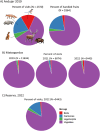The seed dispersal syndrome hypothesis in ungulate-dominated landscapes
- PMID: 38443407
- PMCID: PMC10914747
- DOI: 10.1038/s41598-024-55820-0
The seed dispersal syndrome hypothesis in ungulate-dominated landscapes
Abstract
The Seed Dispersal Syndrome Hypothesis (SDSH) posits that fruit traits predict the main dispersers interacting with plant species. Mammalian dispersers, relying heavily on olfactory cues, are expected to select dull-colored, scented, and larger fruits compared to birds. However, challenges like overabundant seed predators and context-dependency of frugivore-plant interactions complicate SDSH expectations. We studied the Iberian pear, Pyrus bourgaeana, an expected mammal-dispersed tree based on its fruit traits. Extensive camera-trapping data (over 35,000 records) from several tree populations and years revealed visits from seven frugivore groups, with ungulate fruit predators (59-97%) and carnivore seed dispersers (1-20%) most frequent, while birds, lagomorphs, and rodents were infrequent (0-10%). Red deer and wild boar were also the main fruit removers in all sites and years but acted as fruit and seed predators, and thus likely exert conflicting selection pressures to those exerted by seed dispersers. Although, as predicted by the SDSH, most Iberian pear fruits were consumed by large and medium-sized mammals, the traits of Iberian pear fruits likely reflect selection pressures from dispersal vectors in past times. Our results do not challenge the SDHS but do reveal the importance of considering frugivore functional roles for its adequate evaluation.
© 2024. The Author(s).
Conflict of interest statement
The authors declare no competing interests.
Figures

Similar articles
-
Interspecific interactions among functionally diverse frugivores and their outcomes for plant reproduction: A new approach based on camera-trap data and tailored null models.PLoS One. 2020 Oct 16;15(10):e0240614. doi: 10.1371/journal.pone.0240614. eCollection 2020. PLoS One. 2020. PMID: 33064761 Free PMC article.
-
Strong among population variation in frugivory strength by functional diverse frugivores: a 'reciprocal translocation' experiment.Oecologia. 2018 May;187(1):143-154. doi: 10.1007/s00442-018-4102-x. Epub 2018 Mar 2. Oecologia. 2018. PMID: 29497835
-
Evolutionary ecology of climacteric and non-climacteric fruits.Biol Lett. 2021 Sep;17(9):20210352. doi: 10.1098/rsbl.2021.0352. Epub 2021 Sep 15. Biol Lett. 2021. PMID: 34520684 Free PMC article.
-
The mutualism-antagonism continuum in Neotropical palm-frugivore interactions: from interaction outcomes to ecosystem dynamics.Biol Rev Camb Philos Soc. 2022 Apr;97(2):527-553. doi: 10.1111/brv.12809. Epub 2021 Nov 1. Biol Rev Camb Philos Soc. 2022. PMID: 34725900 Free PMC article. Review.
-
Reliability of macaques as seed dispersers.Am J Primatol. 2020 May;82(5):e23115. doi: 10.1002/ajp.23115. Epub 2020 Feb 24. Am J Primatol. 2020. PMID: 32096270 Review.
Cited by
-
Invariant Spatial Pattern Across Mediterranean Scrublands in the Iberian Pear (Pyrus bourgaeana).Ecol Evol. 2025 Jan 18;15(1):e70757. doi: 10.1002/ece3.70757. eCollection 2025 Jan. Ecol Evol. 2025. PMID: 39839340 Free PMC article.
References
-
- Levey, D. J., Silva, W. R., & Galetti, M. (Eds.). Seed Dispersal and Frugivory: Ecology, Evolution, and Conservation (CABI, 2002).
-
- Bascompte J, Jordano P. Mutualistic Networks. Princeton University Press; 2013.
-
- Fleming TH, Kress WJ. The Ornaments of Life: Coevolution and Conservation in the Tropics. University of Chicago Press; 2019.
-
- Corlett RT. Frugivory and seed dispersal. In: Del-Claro K, Torezan-Silingardi HM, editors. Plant-Animal Interactions. Cham: Springer; 2021.
MeSH terms
LinkOut - more resources
Full Text Sources
Miscellaneous

